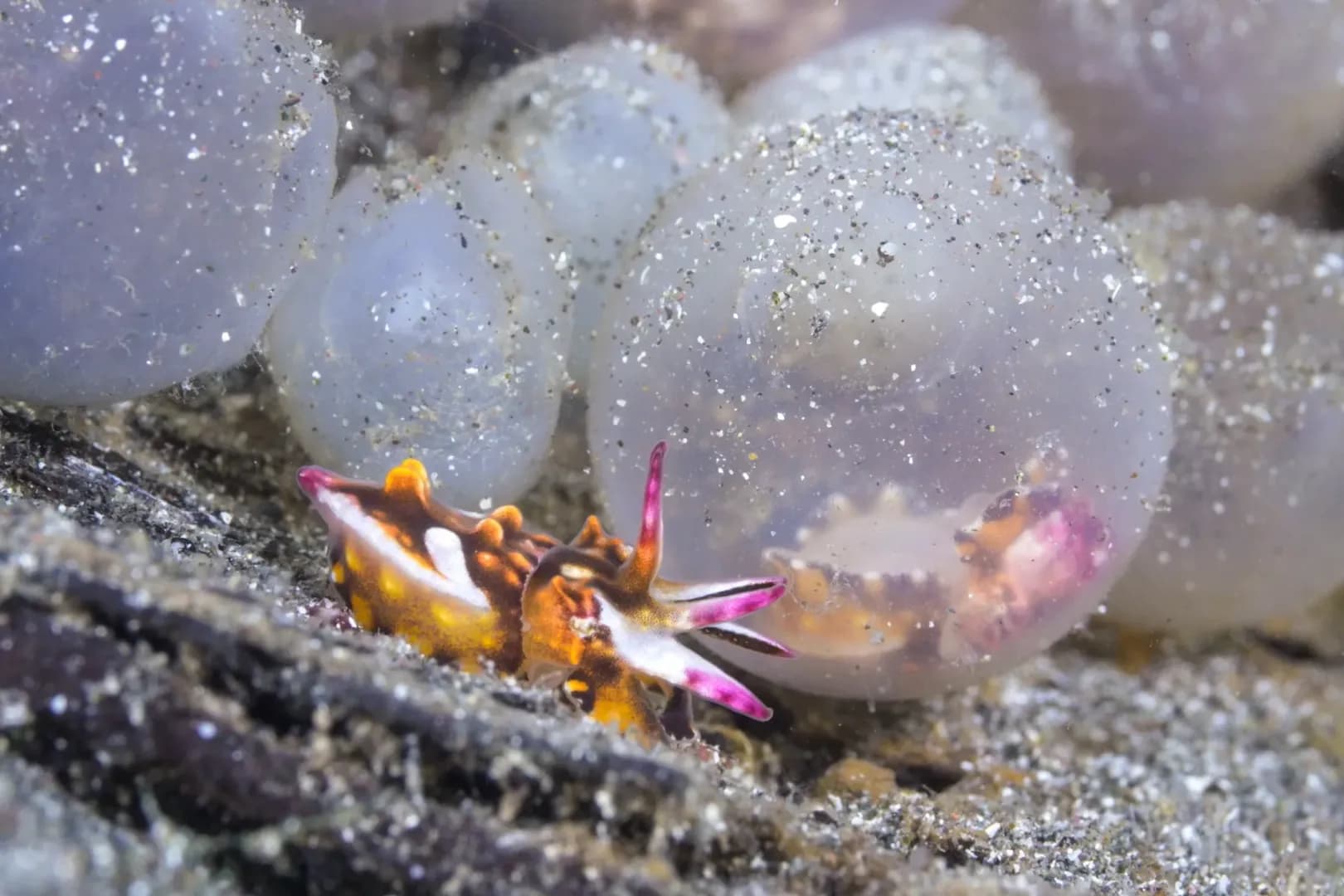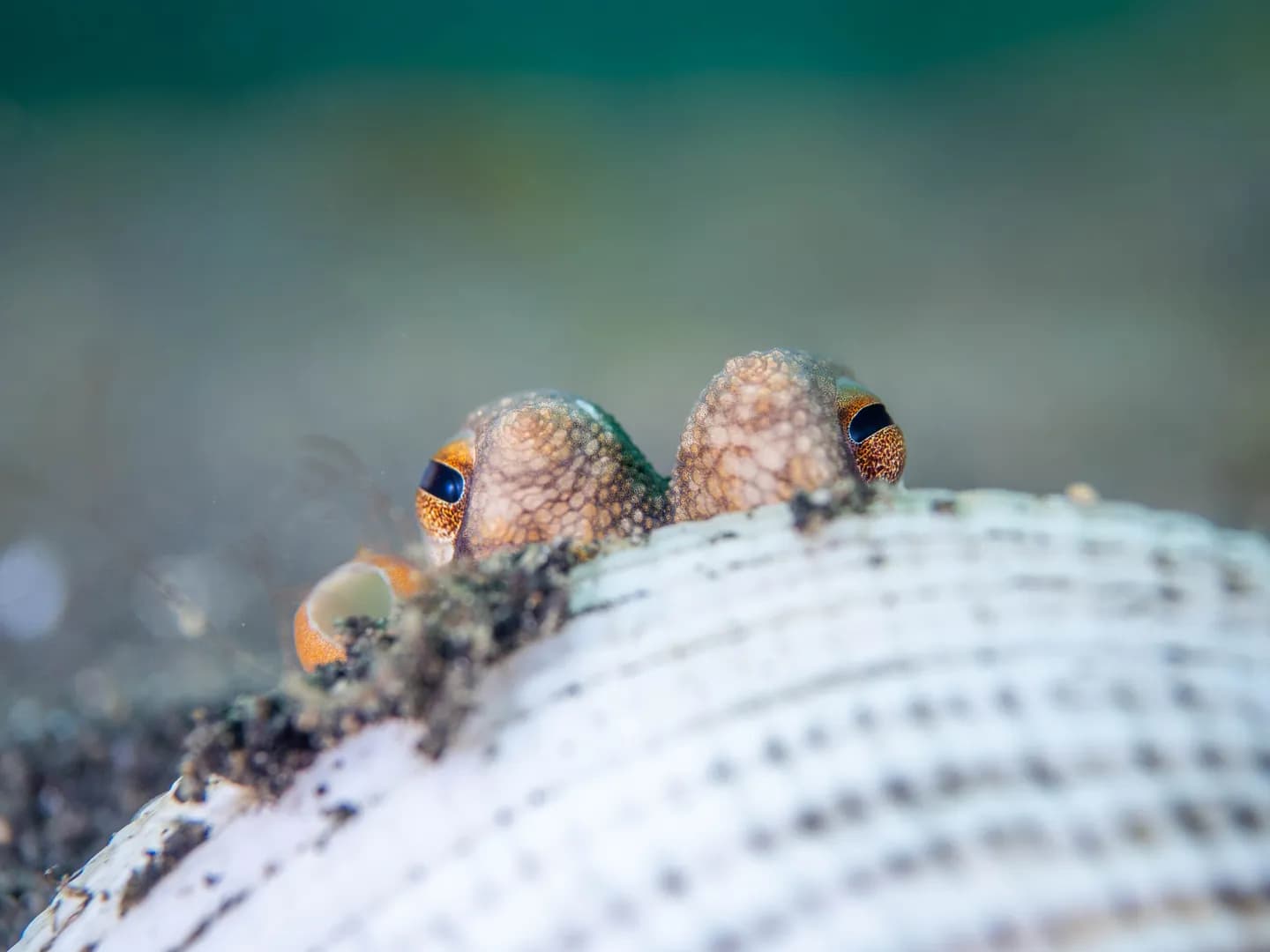Critter Crèche: Where Life Begins in Lembeh

The Lembeh Strait is famous for its extraordinary variety of species. When diving here, you can not only explore and photograph this biodiversity, but also witness the birth of the next generation. If you know where to look, you can view incredible reproductive behaviors such as mating dances, spawning events, and complex parental care.
In this article, we take a closer look at the various solutions nature has devised for passing genes to the next generation. With special focus on eggs, parenting, and embryo development, we’ll reveal how life begins in Lembeh. Let’s dive in.
Spawning at Sunset
Sunsets in the Lembeh Strait are spectacular. And as the sun goes down, Mandarin fish put on an equally unforgettable show. During special Mandarin Fish Dives at Lembeh Resort, you can watch as males and females pair up and perform an elegant courtship dance, spiraling above the coral before releasing their eggs. The fertilized eggs then drift away on the ocean currents.
Corals, too, rely on spawning—but on a vastly different scale and according to a more complicated schedule. Most species reproduce in a mass spawning event that typically takes place just once a year and is coordinated by a combination of moon phase, tides, and water temperatures. When each of these conditions align, entire coral colonies release their eggs and sperm into the water in a synchronized, spectacular bloom.
By spawning en masse, corals give their offspring the best chance of survival – like sea turtles, the strategy is to produce so many eggs that a small proportion will avoid predation, find their way in the world, and reach adulthood. But in Lembeh, we also witness other, more involved parenting strategies too.

Damsels & Devoted Fathers
Damselfish and their close relatives, anemonefish, lay large clutches of eggs attached to hard surfaces by sticky filaments. After laying and fertilization, the male will watch over the eggs for the next 6–10 days, gently fanning them with his fins to oxygenate the developing embryos. As they develop, these eggs take on a characteristic silvery sheen.
In other species like jawfish and cardinalfish, males take parenting to the next level, through a process called mouthbrooding. This involves holding their clutch of eggs in their mouths for protection, and often going without food while they do so. When diving in Lembeh, you may see them occasionally spit out and ‘churn’ the eggs to aerate and clean them.
Some species continue their parental care even after the eggs hatch. Banggai cardinalfish, for example, keep their young safely in their mouths for several days post-hatching, shielding them from predators until they are strong enough to fend for themselves.

Caring Crustaceans, Sygnathiformes, and Sea Slugs
Crustaceans take a different approach. Crabs carry their eggs in a spongy mass between the body and a flap on their underside, while shrimp carry theirs beneath the body using swimmerets. In Lembeh, we sometimes spot peacock mantis shrimps holding a bright pink mass of eggs in their raptorial appendages; these club-like arms pack the strongest punch in the animal kingdom, but can also be surprisingly tender.
Ghost pipefish females carry their eggs in a special pouch formed by fused pelvic fins. Divers who approach from behind may catch a glimpse of these developing eggs, especially when the ghost pipefish opens and closes her fins to aerate them. True pipefish, in contrast, hand the parenting role over to the males, who carry the eggs until hatching.
In keeping with their adult behavior and appearance, nudibranchs have their own unique style of egg laying: they produce ribbons of eggs encased in gelatinous mucus, which are often laid out in colorful spiral patterns. These creations vary in shape and color, and some contain toxins that help ward off predators or bacterial infections.


Cephalopods: Guardians and Strategists
Arguably the most devoted parents belong to the cephalopod family – a group which includes squid, cuttlefish, and octopuses. They enclose their eggs in protective capsules, which can appear gelatinous and transparent or tough and leathery. In Lembeh, divers will sometimes see clusters of sausage-shaped capsules attached to mooring lines or sandy slopes – these eye-catching egg capsules are laid by reef squid. Each one holds between two and nine eggs.
In addition to being one of the most intelligent creatures in the sea, octopuses are famously protective mothers. After laying their eggs, usually in a hidden or sheltered spot, the female will guard them with her life, fastidiously aerating them and keeping them clean until they hatch. Some, like the blue-ringed octopus, even carry the eggs around with them. In most cases, the mother forgoes eating during embryonic development and dies shortly after the eggs hatch – the ultimate parental sacrifice.
Cuttlefish, meanwhile, take a comparatively more hands-off approach. They lay their eggs in sheltered places, often within branching hard corals or in discarded shells, coconut shells, and bottles. Once the eggs are laid, the adults’ work is done. In Lembeh, we’ve witnessed species like broadclub and flamboyant cuttlefish laying – when these eggs hatch, they reveal tiny, perfectly formed replicas of the adults, who are ready to face the world.


Write Your Own Life Story in Lembeh
As each of these tiny critters begins their journey in Lembeh, the whole cycle of life and reproduction begins anew. With every dive, we’re amazed to see nature making plans and finding solutions to the challenges of life. For divers who visit, these miniature moments are a unique experience; the embryo of an unforgettable adventure.
Want to know more about the various reproductive strategies employed by species in the Lembeh Strait? Check out this episode of our Lembeh Learning Series on YouTube.
To begin planning your stay at Lembeh Resort, click here.



